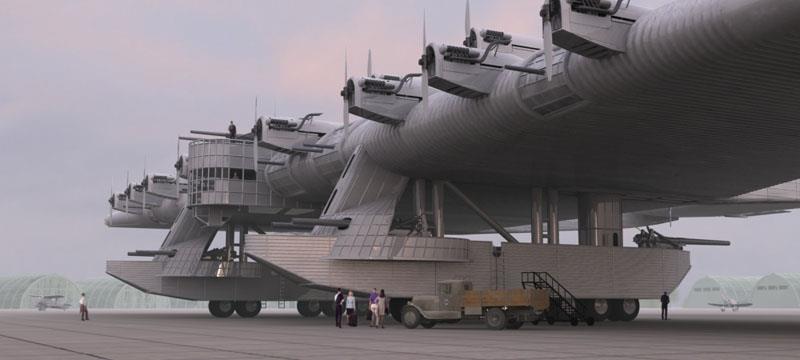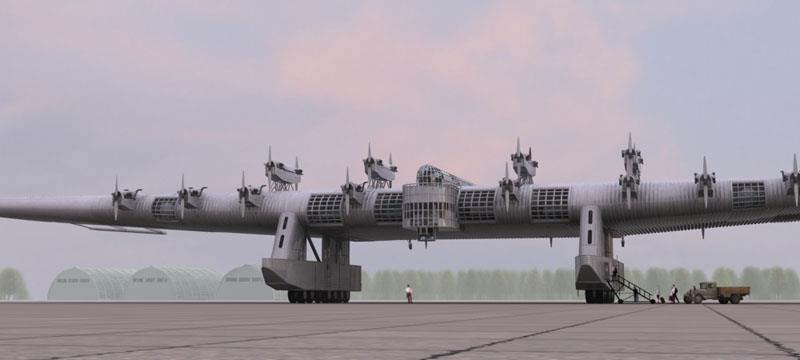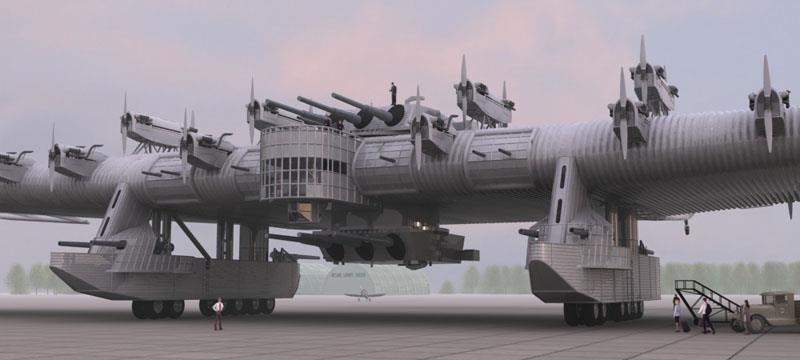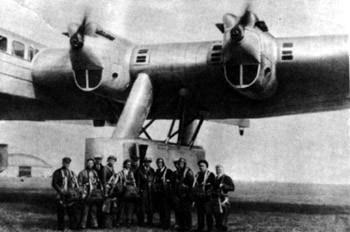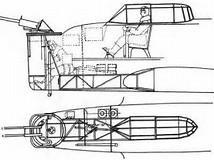A free template by Lucknowwebs.com for WYSIWYG WebBuilder 8
Powered by Sispro1-S
Nigel G Wilcox
Paragon Of Space Publication
© Copyright Reserved - United Kingdom
Ideal Screen Composition 1024 x 768
SITEMAP
SCIENCE RESEARCH
ABOUT
Desk
Supersonic
Stealth
MAIN INDEX
Sea-Air Planes
The Kalinin K-7
The Kalinin K-7 was a heavy experimental aircraft designed and tested in the Soviet Union in the early 1930s. It was of unusual configuration with twin booms and large underwing pods housing fixed landing gear and machine gun turrets. In the passenger version, seats were arranged inside the 2.3-meter thick wings. The airframe was welded from KhMA chrome-molybdenum steel. The original design called for six engines in the wing leading edge but when the projected loaded weight was exceeded, two more engines were added to the trailing edges of the wing, one right and one left of the central passenger pod. Nemecek states in his book that at first only one further pusher engine was added.
Maximum speed: 225 km/h (139.81 mph) Maiden flight: 1933 Length: 91.86 ft Wingspan: 173.92 ft Passengers: 120 Engine type: Mikulin AM-34
The Kalinin K-7 (Russian: калинин к-7; Ukrainian: калінін к-7) was a heavy experimental aircraft designed and tested in the Soviet Union in the early 1930s. It was of unusual configuration with twin booms and large underwing pods housing fixed landing gear and machine gun turrets.
Designed by World War I aviator Konstantin Kalinin with a wingspan greater than a B-52's and a much greater wing area, the K-7 was one of the biggest aircraft built before the jet age. It was only one engine short of the B-52 as well, having the curious arrangement of six pulling on the wing leading edge and one pushing at the rear.
The K-7's very brief first flight showed up instability and serious vibration caused by the airframe resonating with the engine frequency. The solution to this 'flutter' was thought to be to shorten and strengthen the tail booms, little being known then about the natural frequencies of structures and their response to vibration. On the 11th flight, during a speed test, the port tailboom vibrated, fractured, jammed the elevator and caused the giant aircraft to plough into the ground, killing 15.
Undaunted by this disaster, Kalinin's team began construction of two further K-7s in a new factory, but the vicissitudes of Stalin's Russia saw the project abandoned, and in 1938 the arrest and execution of Kalinin on trumped up espionage and sabotage charges.
General characteristics
Crew: minimum 11
Capacity: 120 passengers in civilian configuration
Length: 28 m (91 ft 10 in)
Wingspan: 53 m (173 ft 11 in)
Height: 12.4m (estimated to top of engine shell)
Wing area: 454 m² (4,886.8 ft²)
Empty weight: 24,400 kg (53,793 lb)
Loaded weight: 38,000 kg (83,776 lb)
Powerplant: 7 × Mikulin AM-34F V-12 piston engines, 560 kW (750 hp) each
Performance
Maximum speed: 225 km/h (121 knots, 140 mph)
Service ceiling: 4,000 m (13,123 ft)
Wing loading: 84 kg/m² (17 lb/ft²)
Power/mass: 103 W/kg (0.06 hp/lb)
Role: Heavy bomber/Civilian transport
National origin: Soviet Union
Status: Destroyed in crash
Number built: 1
The K-7 was one of the first metal aircraft with a twin-boom layout.
As originally designed the K-7 was to have engines in the undercarriage sponsons. As completed the bomber had gun positions, the bomb load and an internal staircase as well as two large wheels in each massive sponson.
The K-7's control surfaces were all deflected by the use of large trim tab surfaces mounted on struts.
The K-7 was said to have had a pilot, 18 crew members and one passenger when it crashed, killing all but five crew. It is not clear what they all did, but no doubt tending to the engines was a full-time task.
The Kalinin K-7
S'sonic
Stealth
Menu
Space
Transport
Menu
Topic
Menu
Study
Menu



